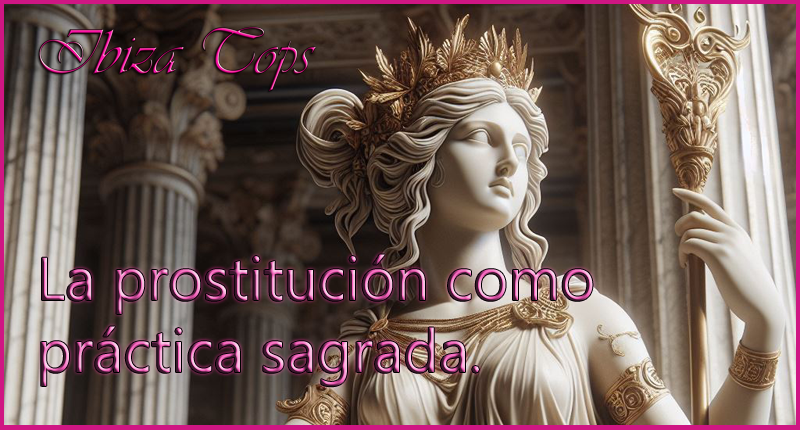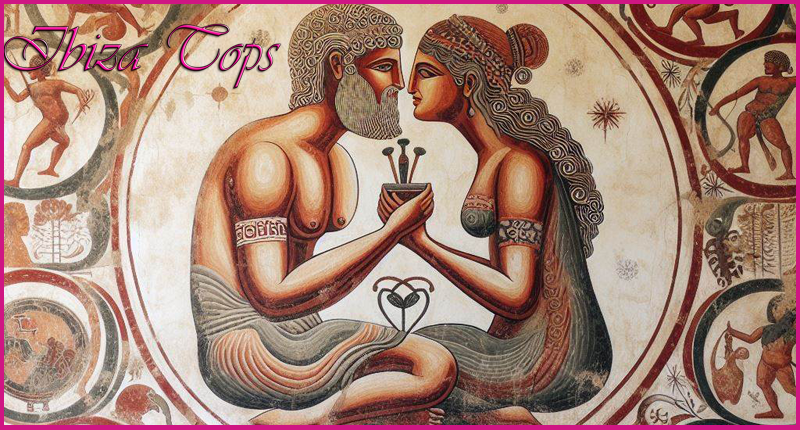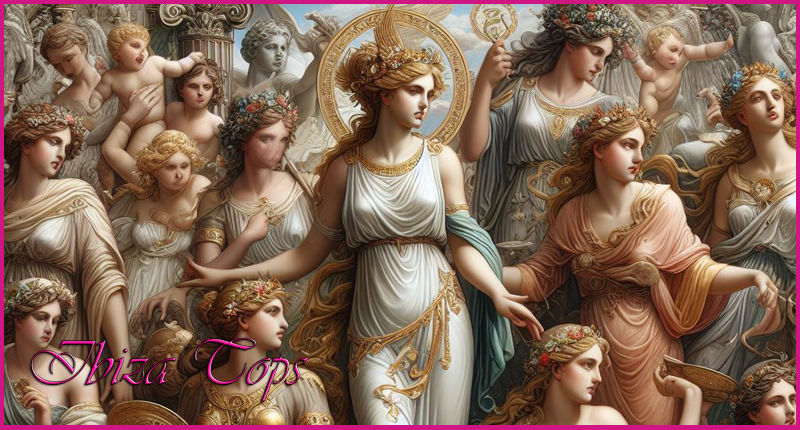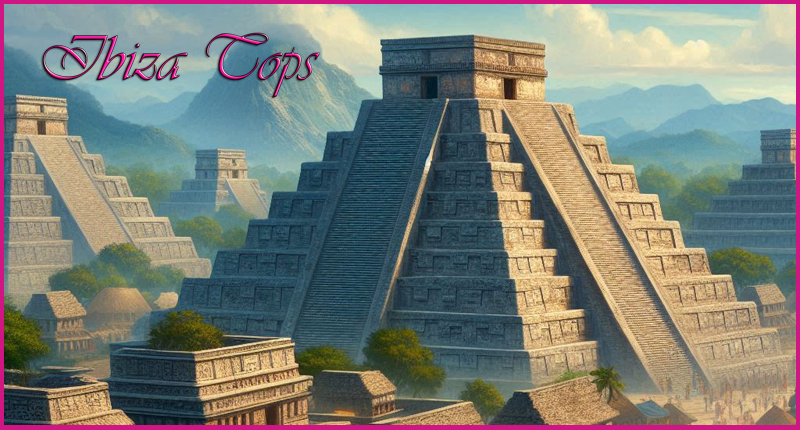PROSTITUTION AS A SACRED PRACTICE.

Sacred prostitution, a highly controversial issue that has also aroused the curiosity of historians and scientists.Temple prostitution or religious prostitution refers to ancient religious ceremonies that involved an intimate sexual act as well as remuneration or benefit for the participants.
It occurred in a context of worship and spirituality, from fertility rites to offerings to the gods.
Sometimes it was between priests and visitors.
In this article we go back in time to learn a little more about this particular practice that had a strong presence in almost all cultures.
"It occurred in a context of worship and spirituality, from fertility rites to offerings to the gods.."
SUMERIANS AND THE FIRST MENTIONS OF SACRED PROSTITUTION.

The oldest mentions of sacred prostitution are found in Sumerian epic literature, the figure of Shamhat was the most important in this practice.
As the myth went, it was Shamhat who seduced Enkidu and Ashu-shu-namir, and rescued Inanna from the underworld.
In this case, sacred prostitution was in honor and devotion to the goddess of sexuality, Inanna.
The ancient historian Herodotus and various other testimonies from the Hellenistic period and Late Antiquity suggest that these societies encouraged the practice of paid sexual rites, not only in Cyprus and Babylon, but throughout the Near East. The English anthropologist James Frazer also holds this belief regarding this ancient civilization and accumulated references to prove the existence of sacred prostitution in his book "The Golden Bough."
There is a copy called The Code of Hammurabi, in very good condition, which is preserved in the Louvre Museum in Paris. There it was recorded that the rights of sacred prostitutes were specifically protected by the same laws that worked for the public dignity of women and children. They could receive inheritance from their parents, qualify for income from the land worked by their brothers and dispose of their properties. This proved to be very advanced for the time."In this case, sacred prostitution was in honor and devotion to the goddess of sexuality, Inanna."
PHENICIANS AND HOMOSEXUAL SACRED PROSTITUTION.

Sacred prostitution, carried out by practitioners of both sexes, was a custom of the Phoenician peoples, which was consecrated to the local deities of Astarte and Adonis, and especially carried out in the form of a festival or social rite in the cities of Byblos, Afca and Baalbek (later called Heliopolis), as well as the nearby Syrian town of Palmyra.
This characteristic reached the Old Testament and thus to us, especially in their Deuteronomic books, where they mentioned in a condemning tone the sacred prostitution of the Phoenicians and Canaanites and censured the Hebrews who had adopted such customs..
There is an archaeological site in Italy of Pirgi (an ancient port in Central Italy), where there was a temple of worship to the goddess Astarte, built with 17 small rooms, which, according to important archaeologists and historians, could have served as sections for the sacred prostitutes would exercise their trade there."Sacred prostitution, carried out by practitioners of both sexes, was a custom of the Phoenician peoples, which was consecrated to the local deities of Astarte and Adonis, and especially carried out in the form of a festival or social rite."
This construction is not the only one that has been found, there was another in the Syrian site of Dura Europos, in a temple of the goddess Atargatis, which had a dozen rooms with benches.
The sacred prostitutes of Pyrgi were well known enough to also be mentioned in a lost fragment of Lucilius' satires.
Sacred prostitution was also present in North Africa, the main area of influence of the Phoenician colony of Carthage, this service was associated in particular with the city of Sicca.
Valerius Maximus described how the women in his temple of Venus (or the associated deity, in this case probably Tanit) earned offerings by prostituting themselves with visitors.
There is an archaeological site located in the province of Badajos, Spain, that belonged to the Phoenician-Punic, such as Cancho Roano, Gadir, Cástulo and la Quéjola (Albacete). This has also suggested this practice through its archeology and iconography.
Cancho Roano has a sanctuary with multiple cells or rooms, probably identified as a place of sacred prostitution in honor of Astarte. A similar institution could have been found in Gádir. The later native dancers and whores, called "puellae gaditanae" in Roman sources (or cinaedi in its male variants), were apparently heirs of this practice, given the ritual context to which sex and dance belonged in Phoenician culture.
CLASSICAL ANTIQUITY, GREECE.

In ancient Greece, sacred prostitution was not only practiced, it was also an attraction of the city of Corinth, whose temple of Aphrodite, goddess of sexuality, housed a large number of courtesans, escorts and whores, called "heteras".This is how the chronicler Strabo, who visited the city personally, described it and said:
The temple of Aphrodite was so sumptuous that it employed more than a thousand heteras with the donations of men and women. Many foreigners visited the city for their sake, and in this way the heteras contributed to the wealth of the city. Ship captains liked to spend their money there, hence the saying: "The trip to Corinth is not for everyone." Another story tells that a woman reproached a hetera for not working the thread as she did, to which the second replied: "Well, look at me carefully, because in this very moment I have already secured three coins."
According to Strabo, the city of Thebes also had the custom of consecrating a maiden called palade to Zeus. This maiden had to come from an illustrious family, be cultured and beautiful; Until the arrival of her menarche, she was allowed to prostitute herself and cohabit with the men she desired, and after that, with a funeral ritual performed, she was granted marriage.
"This type of book allows you to appreciate the true qualities of the escort and so that the client does not get any surprises when he meets her personally."
ROME AND THE CULT OF THE GODDESS APHRODITE.

Rome, more precisely Sicily, was known as one of the greatest renderers of cults and tributes to the goddess Aphrodite or Astaré.
Sacred prostitution was a central part of these rites, the whores and courtesans were usually slaves donated by locals and foreigners alike.
This cult had been implanted by Aeneas, founder of Roman civilization. He reintroduced the Goddess Venus Ericina in Rome under the name of Venus Ericina or Eryxina and ordered the construction of a temple on the Capitoline Hill and another at the Collina Gate.
The historian Diodorius Siculus, who was in his maturity in the year 49 BC, claimed to have spent more than thirty years composing his history called "Biblioteca Historica" which consists of 40 volumes that give us various descriptive accounts of the time. In one of them he wrote that establishing contact with the women of the temple was a possibility only for the Roman consuls and praetors who traveled there. Conventional prostitution was harshly punished by the laws of Rome, however, it occupied a prominent place in various Roman religious celebrations.
Normally, their infamy status prevented them from even approaching priestesses, but this changed during the festivities that took place in the month of April.
That day the women celebrated Fortuna Virilis on the day of Veneralia, a festival in honor of Venus.
According to Ovid (a famous Roman poet of the time), at this festival the whores, prostitutes and courtesans formed groups with married women and they all ritually attended to and cleaned the statue of the goddess Fortune. This act is considered another example of the great influence of faith in the culture of this time, since all social classes came together to honor and celebrate the goddess Aphrodite." In this festival the whores, prostitutes and courtesans formed groups with married women and they all ritually attended to and cleaned the statue of the goddess Fortune."
On the 23rd, whores and courtesans made offerings at the temple of the aforementioned Venus Ericina, a facet of Venus explicitly associated with lenocinium. This date coincided with Vinalia, a festival in honor of wine and the grape harvest.
On the 25th, male homosexual prostitution, the pueri lenonii, took center stage, celebrated on the same day as the harvest festival called Robigalia.
On the 27th the Floralia took place, the festival of the goddess Flora celebrated since 238 BC. C., which included erotic dances and displays of nudity by real and also disguised prostitutes and whores.
The Christian author Lactantius said, in an evidently censorious tone, that "in addition to the freedom of speech that comes with every obscenity, the prostitutes, when bothered by the populace, undressed and acted as mimes before the public, and continued like this." to the maximum satiation of the shameless spectators, whose attention was drawn to her dancing buttocks."
Juvenal also talks about naked dances and even prostitutes fighting like gladiators. Another Christian author, Eusebius, also spoke of sacred prostitution in other temples of Venus in the time of Emperor Constantine, who was forced to close his temples due to pressure from the Christian population.
These acts, which included both heterosexual and homosexual prostitution, also took place in the city of Heliopolis until Constantine banned them.
JAPAN AND THE "ONE NIGHT WIVES".

Japan was not far behind when it came to prostitution as a sacred practice; Shintoism (one of the religions originating in Japan) used this custom in some religious practices.The priestess called Hitoya-zuma ("wife of one night", only high-class courtesans) had the function of symbolically lying with a divinity who visited them at night.
However, other examples included authentic sexual acts with clients, such as the many miko dedicated to pilgrimage, called aruki-miko, who combined their religious services with acts of entertainment and prostitution, and the priestesses of the Echigo and Tanba regions of the Genroku period They raised money for their shrines through this same profession, receiving the colloquial name of kama-harai..
The Mikos, whores and courtesans converged to the point that temples as important as the Tennoji in Osaka or Kitano and Yasaka in Kyoto were strategically located next to the red light districts of their cities."However, other examples included authentic sexual acts with clients, such as the many miko dedicated to pilgrimage, called aruki-miko, who combined their religious services with acts of entertainment and prostitution, and the priestesses of the Echigo and Tanba regions of the Genroku period They raised money for their shrines through this same profession, receiving the colloquial name of kama-harai."
These practices came to an end with the arrival of the Meiji era and the rise of Western Christian morality. The new government policy, called Shinbutsu bunri, was implemented, which reduced the role of the Miko and converted the religion into what was later known as State Shinto.
AMERICA; INCAS, MAYANS AND AZTECS.

The Mayan civilization carried out phallic religious cults that included sacred homosexual prostitution.The Aztecs worshiped Xochipilli, an ancient Toltec deity who served as the patron saint of homosexuals and homosexual prostitution, and her twin Xochiquetzal, patron saint of sexual power and female prostitutes.
This is the case of the Incas, it was young men who practiced sacred prostitution. These dressed in feminine clothes and had ritual sex with chiefs and priests during religious festivities.
SOME CURRENT OPINIONS ABOUT IT.
In her book The Sacred Prostitute: Eternal Aspect of the Feminine, psychoanalyst Nancy Qualls-Corbett emphasized sacred prostitution as an expression of female sexuality and a bridge between it and divinity, as well as a break with all possible worldly sexual degradation. "The sacred prostitute did not make love for the admiration or devotion of whoever came to her...she did not need a man to make sense of her own identity; instead, her identity was rooted in the her own femininity."
Qualls also compared the censorship of sacred prostitution to the demonization of female sexuality and vitalism. "In the temple of the prostitute, men and women encountered life and all the sensual pleasure and delight it had to offer. But, with the change of cultural values and the institutionalization of monotheism and patriarchy, the individual "He went to the house of the Lord to prepare for death."
From IbizaTops we hope that you like this article. We want to wish you an excellent season and we encourage you to continue advertising on the best website for national and international escort ads of the highest level.
IbizaTops. Treat yourself.



